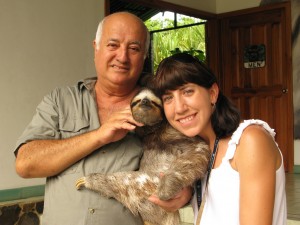In 1722, a French naturalist named Georges Buffon wrote, “These sloths are the lowest form of existence. One more defect would have made their existence impossible.†Buffon was not alone in his opinion. Sloths have been seen for decades as primitive animals incapable of adapting–lazy, stupid, and inept. One of the seven deadly sins, the word “sloth” gained a whole new meaning for us after we docked in Puerto Limon, Costa Rica, and visited the Sloth Sanctuary and Rescue Center of Costa Rica. The only one of its kind, the organization is run by the dedicated Arroyo family and a host of volunteers.
In 1991, the Arroyos opened a bed and breakfast inn where visitors could enjoy lush Cahuita rain forest surroundings with abundant birdwatching opportunities. In 1992, two neighbor girls brought them an orphaned three-toed sloth who would eventually die without her mother. After some research, the Arroyos realized that very little helpful information had been published about the sloth. They named the orphan Buttercup, and they learned how to raise her. She is still thriving at the sanctuary, and is, as you can see below, quite photogenic. (That’s Mr. Arroyo holding her.)

Over time, people began hearing of their work and bringing more sloths to their door. Some suffered habitat loss, while others had been orphaned, electrocuted by power lines, run over by cars, or (worst of all) victims of senseless violence. An impressive 80% of the sloths received by the Sanctuary are rehabilitated and returned to the wild. Of the remaining 20%, those that survive their injuries but cannot return to the rain forest receive the love and care they need to live healthy and happy lives at the Sanctuary. Visitors can stay at the B&B for an extended period of time, but even if you stay for only a few hours like we did, you can learn a lot about sloths and about yourself.
Some interesting sloth facts:
- They only move three miles per hour, which is why they so often get hit by cars.
- The males have no visible genitalia. The females don’t seem to mind this. How do we know? They make babies anyway.
- They are herbivores and come in two-toed and three-toed varieties.
- They only sleep for about 8 hours a day, like people.
- They have perpetual peaceful smiles on their faces.
- They are curious, kind creatures…but they do have the ability to rip your face off. They just resist the urge.
- As the Arroyos say, “We all know of sloths, but almost nothing about them.”
The Arroyo family isn’t just saving sloths–they are educating people and shifting paradigms the world over. In 1999, a group in Japan was so inspired by the sloth that they formed a worldwide NGO called The Sloth Club. Among other earth friendly missions, the club spreads the sloth gospel around the world by encouraging people to “shift from the culture of more, faster, and tougher to that of less, slower, and nonviolent.” I think Buttercup is pleased to know that she is helping the Arroyos to teach so many people that slow is beautiful.

One Comment